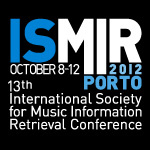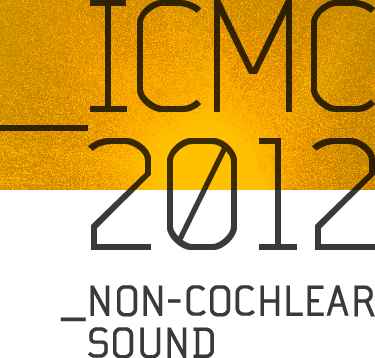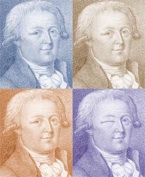» By Joren on Wednesday 05 December 2012
Today marks the reslease of Tarsos 1.0 . The new Tarsos release contains practical transcription features. As can be seen in the screenshot below, a time stretching feature makes it easy to loop a certain audio fragment while it is playing in a slow tempo. The next loop can be played with by pressing the n key, the one before by pressing b.
Since the pitch classes can be found in a song, and there is a feature that lets you play a MIDI keyboard in the tone scale of the song under analysis, transcription of ethnic music is made a lot easier.
The new release of Tarsos can be found in the Tarsos release repository. From now on, nightly releases are uploaded there automatically.
 HoGent
HoGent
» By Joren on Monday 05 November 2012
The DSP library for Taros, aptly named TarsosDSP, now includes an implementation of a pitch shifting algorithm (as of version 1.4). The goal of pitch shifting is to change the pitch of a piece of audio without affecting the duration. The algorithm implemented is a combination of resampling and time stretching. Resampling changes the pitch of the audio, but affects the total duration. Consecutively, the duration of the audio is stretched to the original (without affecting pitch) with time stretching. The result is very similar to phase vocoding.
The example application below shows how to pitch shift input from the microphone in real-time, or pitch shift a recorded track with the TarsosDSP library.
To test the application, download and execute the PitchShift.jar file and load an audio file. For the moment only 44.1kHz mono wav is allowed. To get started you can try “this piece of audio”:[08._Ladrang_Kandamanyura_10s-20s.wav].
There is also a command line interface, the following command lowers the pitch of in.wav by two semitones.
java -jar in.wav out.wav -200
----------------------------------------------------
_______ _____ _____ _____
|__ __| | __ \ / ____| __ \
| | __ _ _ __ ___ ___ ___| | | | (___ | |__) |
| |/ _` | '__/ __|/ _ \/ __| | | |\___ \| ___/
| | (_| | | \__ \ (_) \__ \ |__| |____) | |
|_|\__,_|_| |___/\___/|___/_____/|_____/|_|
----------------------------------------------------
Name:
TarsosDSP Pitch shifting utility.
----------------------------------------------------
Synopsis:
java -jar PitchShift.jar source.wav target.wav cents
----------------------------------------------------
Description:
Change the play back speed of audio without changing the pitch.
source.wav A readable, mono wav file.
target.wav Target location for the pitch shifted file.
cents Pitch shifting in cents: 100 means one semitone up,
-100 one down, 0 is no change. 1200 is one octave up.
The resampling feature was implemented with libresample4j by Laszlo Systems. libresample4j is a Java port of Dominic Mazzoni’s libresample 0.1.3, which is in turn based on Julius Smith’s Resample 1.7 library.
 HoGent
HoGent
 pitch-shift-in-java.png and 08._Ladrang_Kandamanyura_10s-20s.wav
pitch-shift-in-java.png and 08._Ladrang_Kandamanyura_10s-20s.wav
» By Joren on Monday 08 October 2012
 The 13th International Society for Music Information Retrieval Conference took place in Porto, Portugal, October 8th-12th, 2012. This text contains links to some papers, toolkits, software presented there which are interesting for my research. Basically it contains my personal highlights of the conference. The ISMIR 2012 is described as follows:
The 13th International Society for Music Information Retrieval Conference took place in Porto, Portugal, October 8th-12th, 2012. This text contains links to some papers, toolkits, software presented there which are interesting for my research. Basically it contains my personal highlights of the conference. The ISMIR 2012 is described as follows:
The annual Conference of the International Society for Music Information Retrieval (ISMIR) is the world’s leading research forum on processing, searching, organizing and accessing music-related data. The revolution in music distribution and storage brought about by digital technology has fueled tremendous research activities and interests in academia as well as in industry. The ISMIR Conference reflects this rapid development by providing a meeting place for the discussion of MIR-related research, developments, methods, tools and experimental results. Its main goal is to foster multidisciplinary exchange by bringing together researchers and developers, educators and librarians, as well as students and professional users.
Tutorials
I saw an interesting tutorial on Jazz music and a tutorial on source separation. After an introduction, which detailed the experimental basis of the system, a source separator was introduced. The REPET source separator is a relatively simple system that yields reasonable results to split accompaniment from foreground melody.
Posters & Talks
The approach and the dataset used in N-gram Based Statistical Makam Detection on Makam Music in Turkey Using Symbolic Data is very interesting. More than 800 pieces of makam music where transcribed manually and analysed. Details about the dataset are available in the following paper: A Turkish Makam Music Symbolic Database for Music Information Retrieval: SymbTr.
Assigning a Confidence Threshold on Automatic Beat Annotation in Large Datasets by Zapata et al. shows a very interesting way to do exactly what the title says. Descriptive titles are descriptive.
A very practical tool to do melody extraction was presented by Justin Salamon. He created a Vamp Plugin with the name Melodia. Unfortunately the plugin is currently only available for windows, but Linux and OS X versions are in the pipeline. More about the algorithm implemented and background information can be found in the paper Justin presented: Statistical Characterisation of Melodic Pitch Contours and its Application for Melody Extraction. Another Vamp Plugin for melody visualization was also presented: Pitch Content Visualization Tools for Music Performance Analysis.
The ongoing work by Ceril Bohak and Matija Marolt on segmentation of folk music could be very useful to apply on Afican musics. The paper is called Finding Repeating Stanzas in Folk Songs.
 HoGent
HoGent
 ismir_2012.jpg
ismir_2012.jpg
» By Joren on Friday 31 August 2012
 At this years ICMC Conference, ICMC 2012 we presented a paper describing a way to experiment with tone scales and how to use Tarsos as a compositional tool. What follows are some pointers to the presentation, paper and to other interesting talks that were presented there.
At this years ICMC Conference, ICMC 2012 we presented a paper describing a way to experiment with tone scales and how to use Tarsos as a compositional tool. What follows are some pointers to the presentation, paper and to other interesting talks that were presented there.
ICMC 2012 was organized in Ljubljana from the 9 to 14 septembre and had a very dense program of talks, posters, presentations, demos and concerts.
Since 1974 the International Computer Music Conference has been the major international forum for the presentation of the full range of outcomes from technical and musical research, both musical and theoretical, related to the use of computers in music. This annual conference regularly travels the globe, with recent conferences in the Americas, Europe and Asia. This year we welcome the conference to Slovenia for the first time.
### Sound to Scale to Sound, a Setup for Microtonal Exploration and Composition
Our contribution to the conference was a paper titled “Sound to Scale to Sound, a Setup for Microtonal Exploration and Composition”:[icmc2012_submission_45.pdf].
If you want to cite our work, this BibTeX entry is included for your convenience:
```ruby\
\@inproceedings{cornelis2012sound_to_scale,\
author = {Olmo Cornelis and Joren Six},\
title = {{Sound to Scale to Sound, a Setup for Microtonal Exploration and Composition}},\
booktitle = {{Proceedings of the 2012 International Computer Music Conference,\
(ICMC 2012)}},\
year = {2012},\
publisher = {The International Computer Music Association}\
}\
```
Program highlights
What follows are a number of pointers to my personal program highlights.
Verena Thomas presented two very well polished software tools. One to detect patterns in scores, called motifviewer and a tool to search in score databases in a multi-modal way. The Probado tool does score-to-audio alignment and much more.
Gibber is an impressive live-coding environment with an easy syntax. Since it is all done with javascript you can start playing with it immediately. Overtone Another live-coding environment, presented at the conference by Sam Aaron, was equally impressive. It is programmed using the Closure language.
At ICMC there were a number of tools to assist in composition. One of those is The Bach Project, by Andrea Agostini. Togheter with CatART by Diemo Swartz it forms a very expressive platform to work with sound, which was demonstrated by Aaron Einbond and Christopher Trapani in their paper titled Precise Pitch Control In Real Time Corpus-Based Concatenative Synthesis. Diemo Swartz presented work on Audio Mosaicing, it can be seen as a follow-up to AuidioGuild by Ben Hackbarth.
I also got to know the work by Thomas Grill, on his website a nice piece of software can be found a Python implementation of the Non Stationary Gabor Transform (NSGT). Another software system I got to know is the functional signal processing programming language FAUST
My personal highlights of the concert programme include the works by Johannes Kreidler, Aura Pon, Daniel Mayer, Alexander Schubert and the remarkable performance by Dexter Ford. The concept behind Soundlog by Johannes Kretz was also interesting.
 HoGent
HoGent
 ICMC_Logo.png, icmc2012_submission_45.pdf, and 2012.09.08-Sound_to_Scale_to_Sound__a_Setup_for_Microtonal_Exploration_and_Composition.odp
ICMC_Logo.png, icmc2012_submission_45.pdf, and 2012.09.08-Sound_to_Scale_to_Sound__a_Setup_for_Microtonal_Exploration_and_Composition.odp
» By Joren on Friday 31 August 2012
 What follows is about the Conference on Interdisciplinary Musicology (CIM2012) and the 15th international Conference of the Gesellschaft fur Musikfoschung. First this text will give information about our contribution to CIM2012: Revealing and Listening to Scales From the Past; Tone Scale Analysis of Archived Central-African Music Using Computational Means and then a number of highlights of the conference follow. The joint conference took place from the 4th to the 8th of september 2012.
What follows is about the Conference on Interdisciplinary Musicology (CIM2012) and the 15th international Conference of the Gesellschaft fur Musikfoschung. First this text will give information about our contribution to CIM2012: Revealing and Listening to Scales From the Past; Tone Scale Analysis of Archived Central-African Music Using Computational Means and then a number of highlights of the conference follow. The joint conference took place from the 4th to the 8th of september 2012.
In 2012, CIM will tackle the subject of History. Hosted by the University of Göttingen, whose one time music director Johann Nikolaus Forkel is widely regarded as one of the founders of modern music historiography, CIM12 aims to promote collaborations that provoke and explore new methods and methodologies for establishing, evaluating, preserving and communicating knowledge of music and musical practices of past societies and the factors implicated in both the preservation and transformation of such practices over time.
### Revealing and Listening to Scales From the Past; Tone Scale Analysis of Archived Central-African Music Using Computational Means
Our contribution ton CIM 2012 is titled “Revealing and Listening to Scales From the Past; Tone Scale Analysis of Archived Central-African Music Using Computational Means”:[CIM12_Submission.pdf]. The aim was to show how tone scales of the past, e.g. organ tuning, can be extracted and sonified. During the demo special attention was given to historic Central African tuning systems. The presentation I gave is included below and or available for “download”:[2012.09.05-Revealing_and_listening_to_scales_from_the_past__tone_scale_analysis_of_archived_Central-African_music_using_computational_means..ppt]
Highlights
What follows are some personal highlights for the Conference on Interdisciplinary Musicology (CIM2012) and the 15th international Conference of the Gesellschaft fur Musikfoschung. The joint conference took place from the 4th to the 8th of september 2012.
The work presented by Rytis Ambrazevicius et al. Modal changes in traditional Lithuanian singing: Diachronic aspect has a lot in common with our research, it was interesting to see their approach. Another highlight of the conference was the whole session organized by Klaus-Peter Brenner around Mbira music.
Rainer Polak gave a talk titled ‘Swing, Groove and Metre. Asymmetric Feels, Metric Ambiguity and Metric Transformation in African Musics’. He showed how research about rhythm in jazz research, music theory and empirical musicology ( amongst others) could be bridged and applied to ethnic music.
The overview Eleanore Selfridge-Field gave during her talk Between an Analogue Past and a Digital Future: The Evolving Digital Present was refreshing. She had a really clear view on all the different ways musicology and digital media can benifit from each-other.
From the concert programme I found two especially interesting: the lecture-performance by Margarete Maierhofer-Lischka and Frauke Aulbert of Lotofagos, a piece by Beat Furrer and Burdocks composed and performed by Christian Wolff and a bunch of enthusiastic students.
 HoGent
HoGent
 2012.09.05-Revealing_and_listening_to_scales_from_the_past__tone_scale_analysis_of_archived_Central-African_music_using_computational_means..ppt, CIM12_Submission.pdf, and Forkeljpg.jpg
2012.09.05-Revealing_and_listening_to_scales_from_the_past__tone_scale_analysis_of_archived_Central-African_music_using_computational_means..ppt, CIM12_Submission.pdf, and Forkeljpg.jpg
» By Joren on Wednesday 06 June 2012
At the 2012 AAWM (Analytical Approaches To World Music) conference we presented a way to explore tone scales in the music of Central Africa. Since the audience consisted of (ethno)musicologists, the main focus of the presentation was on the applicication part, the technical aspects were only briefly mentioned.
The extended abstract can be consulted: Towards the tangible: microtonal scale exploration in Central-African music
The conference program itself was very diverse and interesting.
 HoGent
HoGent
 2012.05.11-Towards_the_Tangible_-_Microtonal_Scale_Exploration_in_Central-African_Music.odp and AAWM_abstract_short.doc
2012.05.11-Towards_the_Tangible_-_Microtonal_Scale_Exploration_in_Central-African_Music.odp and AAWM_abstract_short.doc
» By Joren on Tuesday 05 June 2012
Today a new version of the TarsosDSP library was released. TarsosDSP is a small library to do audio processing in Java. It features two new pitch detectors. An AMDF (Average Magnitude Difference Function) pitch detector, contributed by Eder Souza of Brazil and a faster implementation of YIN kindly provided by Matthias Mauch of Queen Mary University, London.
[](/releases/TarsosDSP/TarsosDSP-1.2/TarsosDSP-1.2-Examples/PitchDetector-1.2.jar)
Find your oven fresh baked binaries at the TarsosDSP Release Repository.
 HoGent
HoGent
 PitchDetector.png
PitchDetector.png
» By Joren on Monday 07 May 2012
Thursday the 3th of May I gave a guest lecture titled ‘Ethnic Music Analysis: Challenges & Opportunities’ it featured Tarsos as a Case Study. The goal was to identify the difficulties when dealing with ethnic music and to show a possible approach, the approach implemented by Tarsos.
The invitation to give the guest lecture came from Michael Cuthbert who is one of the driving forces behind music21. The audience was a small group of double majors in both musicology and computer science: the ideal profile to gather useful feedback.
 HoGent
HoGent
 2012.05.03-Ethnic_Music_Analysis.odp and 2012.05.03-Ethnic_Music_Analysis.pdf
2012.05.03-Ethnic_Music_Analysis.odp and 2012.05.03-Ethnic_Music_Analysis.pdf
» By Joren on Tuesday 24 April 2012
After about a year of development and several revisions TarsosDSP has enough features and is stable enough to slap the 1.0 tag onto it. A ‘read me’, manual, API documentation, source and binaries can be found on the TarsosDSP release directory. The source is present in the\
What follows below is the information that can be found in the read me file:
TarsosDSP is a collection of classes to do simple audio processing. It features an implementation of a percussion onset detector and two pitch detection algorithms: Yin and the Mcleod Pitch method. Also included is a Goertzel DTMF decoding algorithm and a time stretch algorithm (WSOLA).
Its aim is to provide a simple interface to some audio (signal) processing algorithms implemented in pure JAVA. Some TarsosDSP example applications are available.
The following example filters a band of frequencies of an input file testFile. It keeps the frequencies form startFrequency to stopFrequency.
<code>AudioInputStream inputStream = AudioSystem.getAudioInputStream(testFile);
AudioDispatcher dispatcher = new AudioDispatcher(inputStream,stepSize,overlap);
dispatcher.addAudioProcessor(new HighPass(startFrequency, sampleRate, overlap));
dispatcher.addAudioProcessor(new LowPassFS(stopFrequency, sampleRate, overlap));
dispatcher.addAudioProcessor(new FloatConverter(format));
dispatcher.addAudioProcessor(new WaveformWriter(format,stepSize, overlap, "filtered.wav"));
dispatcher.run();
</code>
Quickly Getting Started with TarsosDSP
Head over to the TarsosDSP release repository and download the latest TarsosDSP library. To get up to speed quickly, check the TarsosDSP Example applications for inspiration and consult the API documentation. If you, for some reason, want to build from source, you need Apache Ant and git installed on your system. The following commands fetch the source and build the library and example jars:
git clone https://JorenSix@github.com/JorenSix/TarsosDSP.git
cd TarsosDSP/build
ant tarsos_dsp_library #Builds the core TarsosDSP library
ant build_examples #Builds all the TarsosDSP examples
ant javadoc #Creates the documentation in TarsosDSP/doc
\
When everything runs correctly you should be able to run all example applications and have the latest version of the TarsosDSP library for inclusion in your projects. Also the Javadoc documentation for the API should be available in TarsosDSP/doc. Drop me a line if you use TarsosDSP in your project. Always nice to hear how this software is used.
Source Code Organization and Examples of TarsosDSP
The source tree is divided in three directories:
-
src contains the source files of the core DSP libraries.
-
test contains unit tests for some of the DSP functionality.
-
build contains ANT build files. Either to build Java documentation or runnable JAR-files for the example applications.
-
examples contains a couple of example applications with a Java Swing user interface:
-
SoundDetector show how you loudness calculations can be done. When input sound is over a defined limit an event is fired.
-
PitchDetector this demo application shows real-time pitch detection. When pitch is detected the hertz value is printed together with a probability.
-
PercussionDetector show the percussion (onset) dectection. Clapping your hands causes an event. This demo application also shows the influence of the two parameters on the algorithm.
-
UtterAsterisk a game with the goal to sing as close to a melody a possible. Technically it shows real-time pitch detection with YIN or MPM.
-
Spectrogram in Java shows a spectrogram and detected pitch, either live or from an audio file. It is interesting to see which frequencies are picked as fundamentals.
-
Goertzel DTMF decoding an implementation of the Goertzel Algorithm. A fancy user interface shows what goes on under the hood.
-
Audio Time Stretching -- Implementation in Pure Java Using WSOLA an implementation of a time stretching algorithm. WSOLA makes it possible to change the play back speed of audio without changing the pitch. The play back speed can be changed at any moment, even when there is audio playing.
 HoGent
HoGent
» By Joren on Friday 09 March 2012
The DSP library for Taros, aptly named TarsosDSP, now includes an implementation of an oscilloscope.
"":\[OscilloscopeExample.jar\]
The source code of the Java implementation can be found on the TarsosDSP github page. That is all.
 HoGent
HoGent
Previous blog posts


 \
\

 The 13th International Society for Music Information Retrieval Conference took place in Porto, Portugal, October 8th-12th, 2012. This text contains links to some papers, toolkits, software presented there which are interesting for my research. Basically it contains my personal highlights of the conference. The
The 13th International Society for Music Information Retrieval Conference took place in Porto, Portugal, October 8th-12th, 2012. This text contains links to some papers, toolkits, software presented there which are interesting for my research. Basically it contains my personal highlights of the conference. The  At this years ICMC Conference,
At this years ICMC Conference,  What follows is about the
What follows is about the